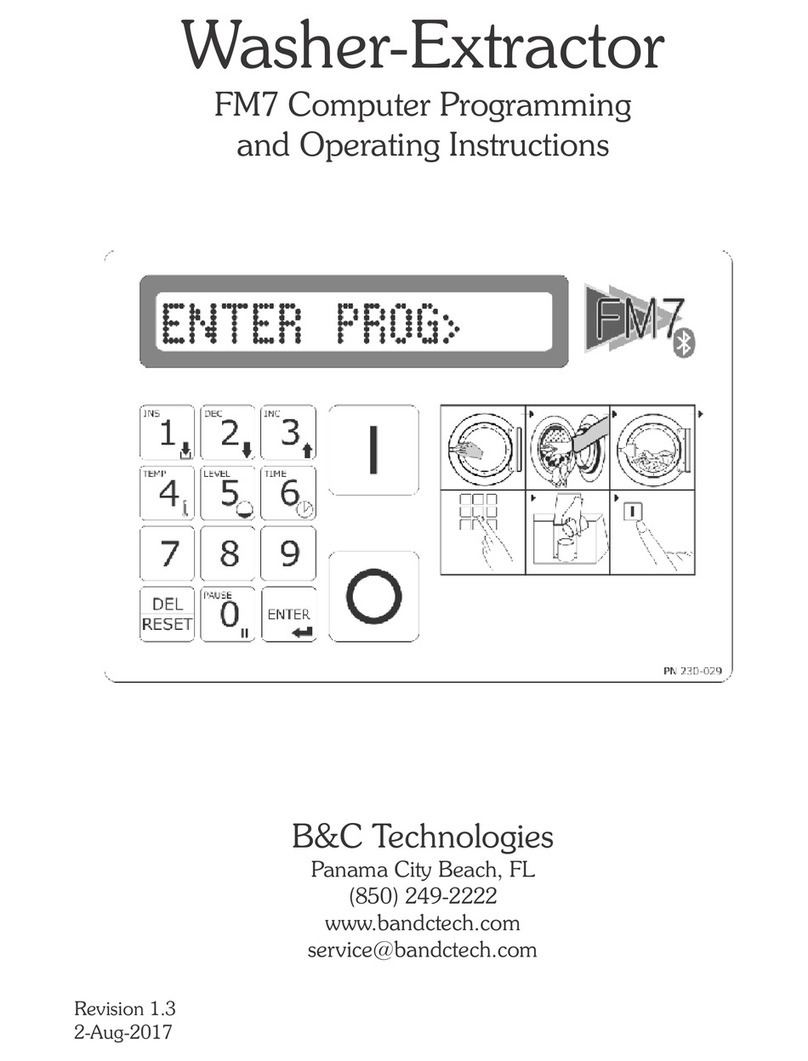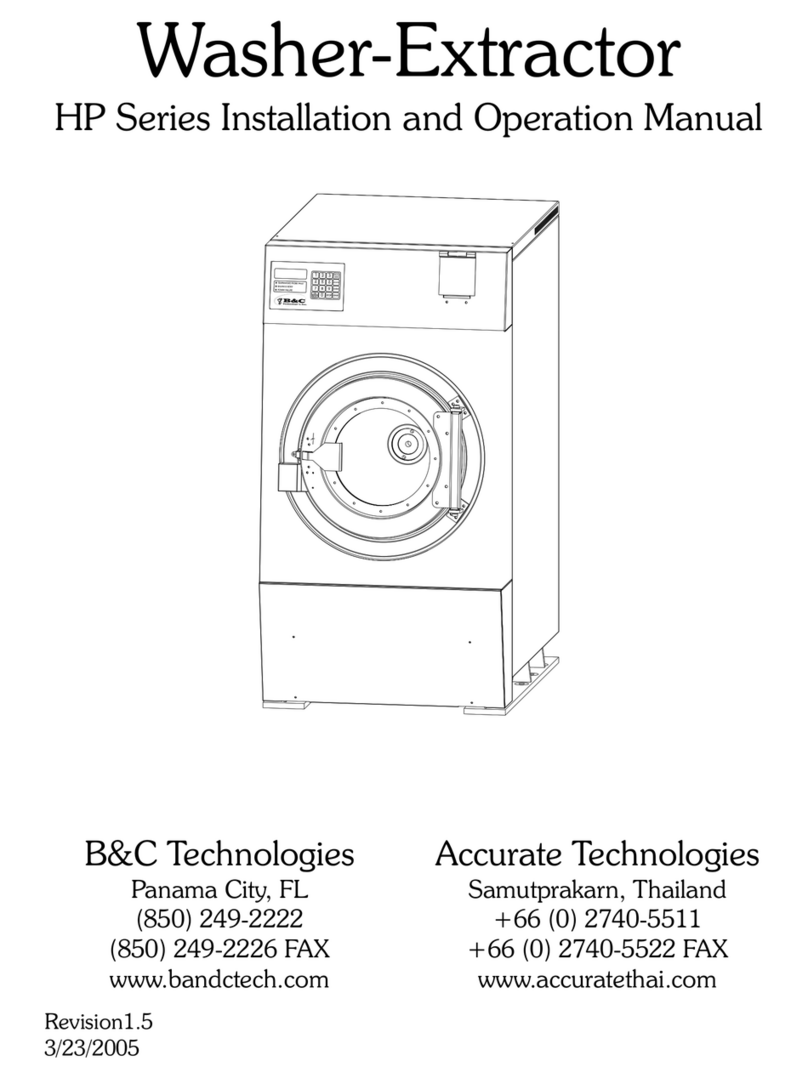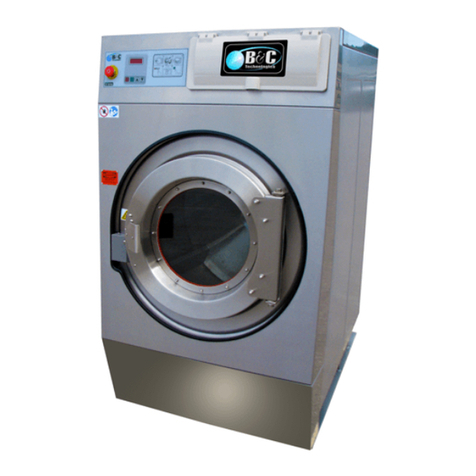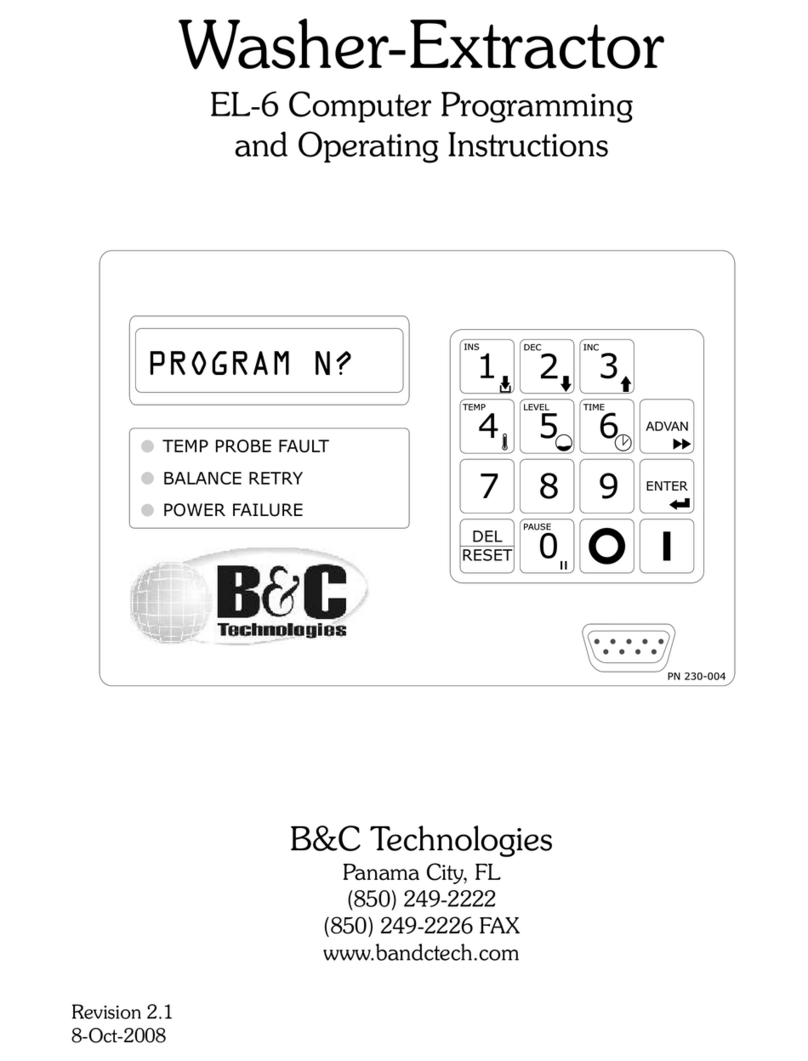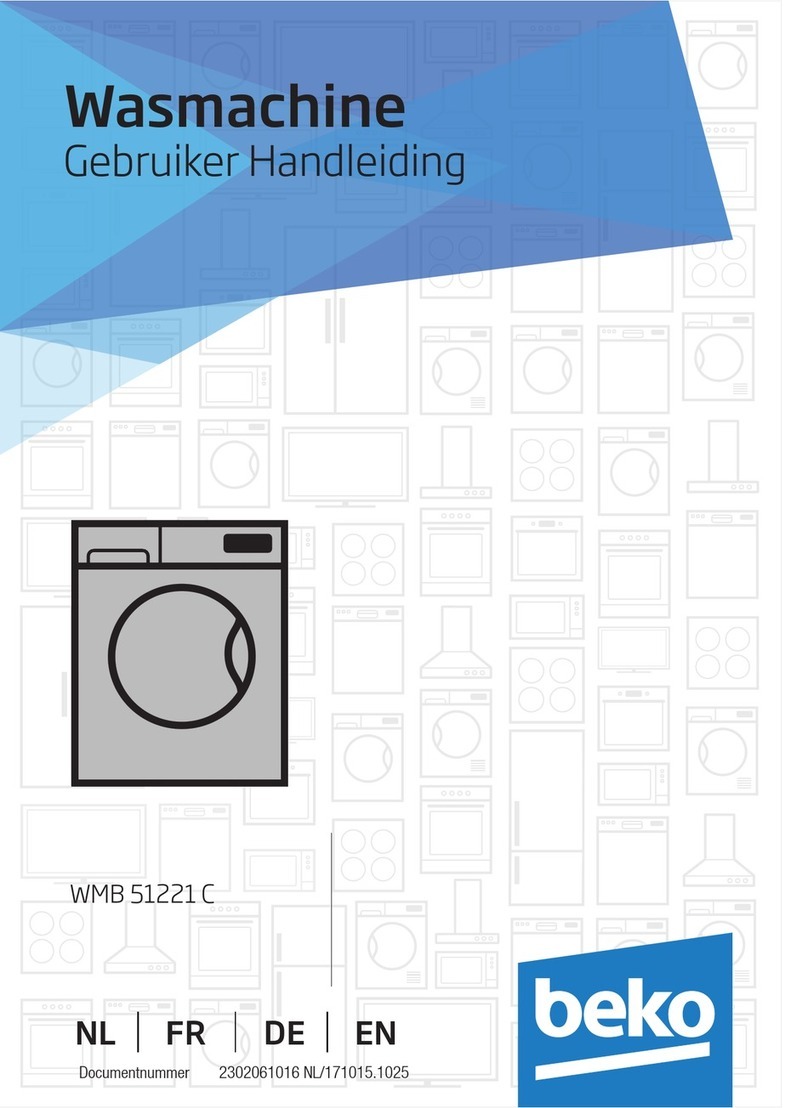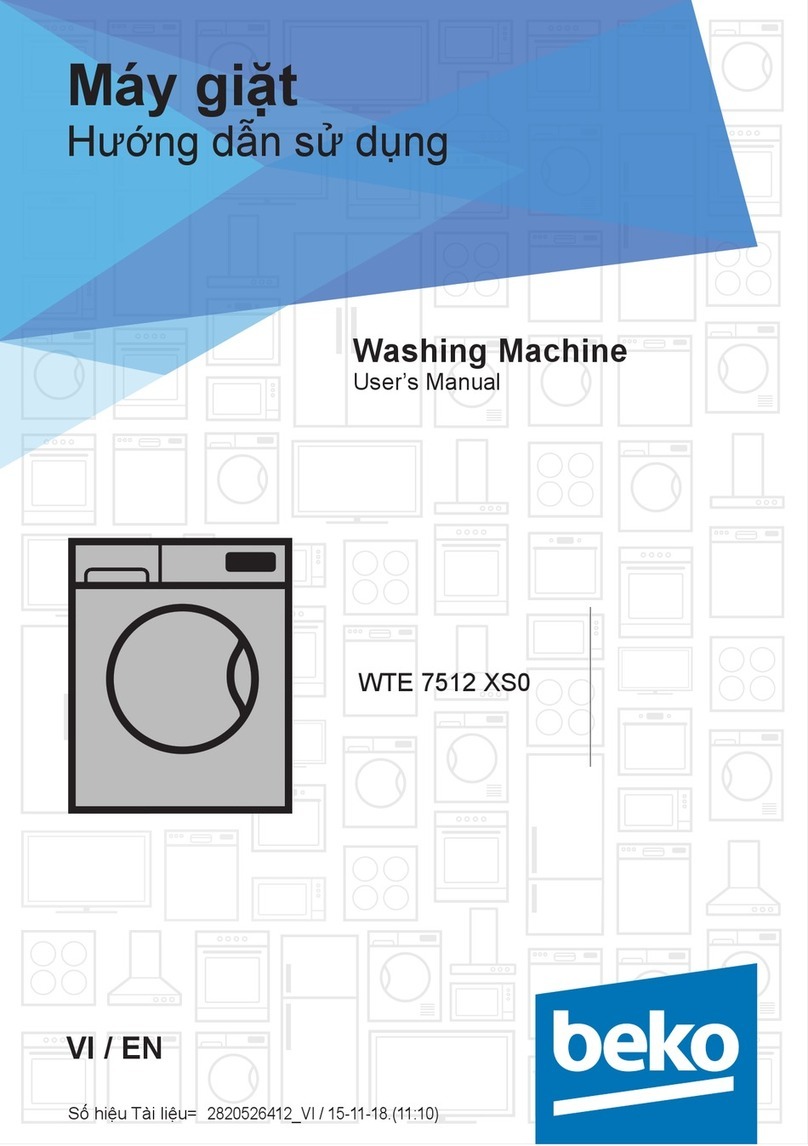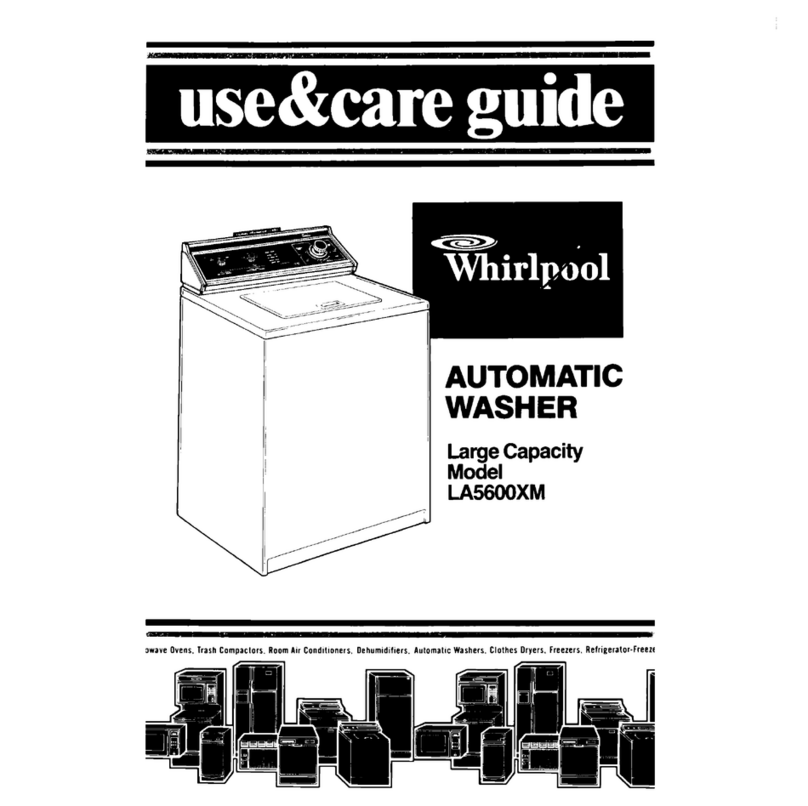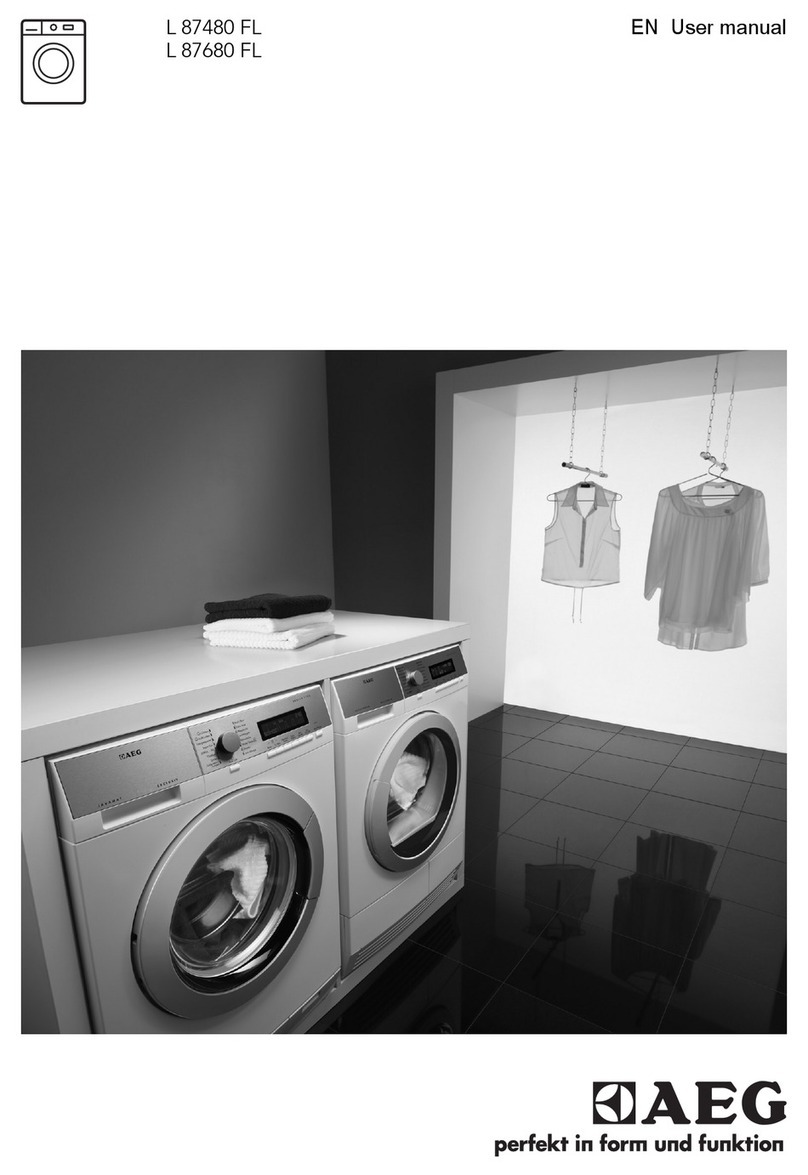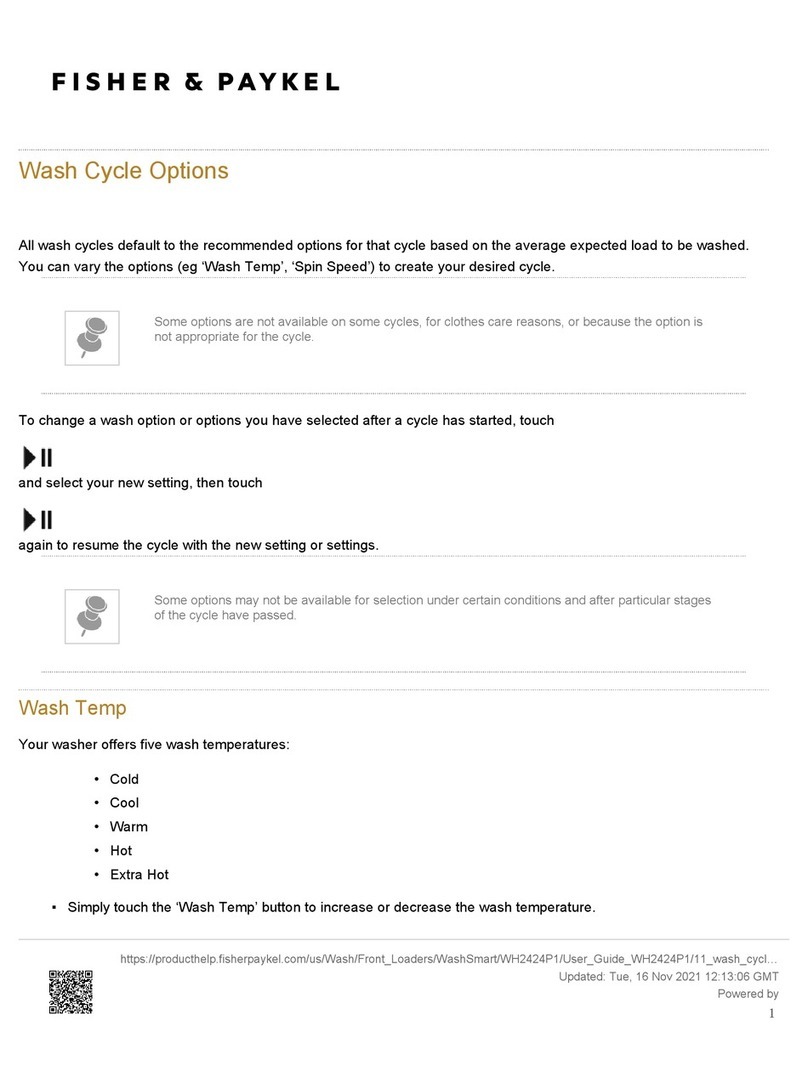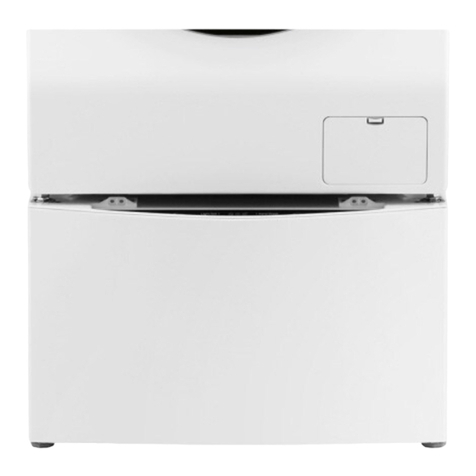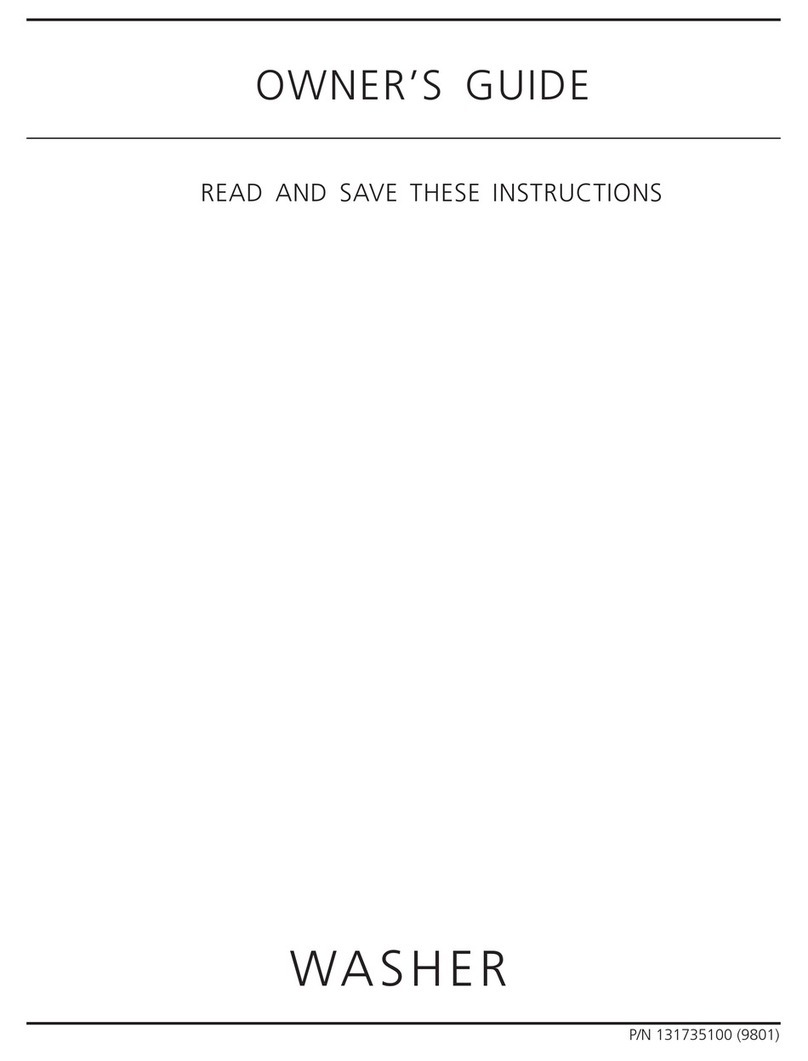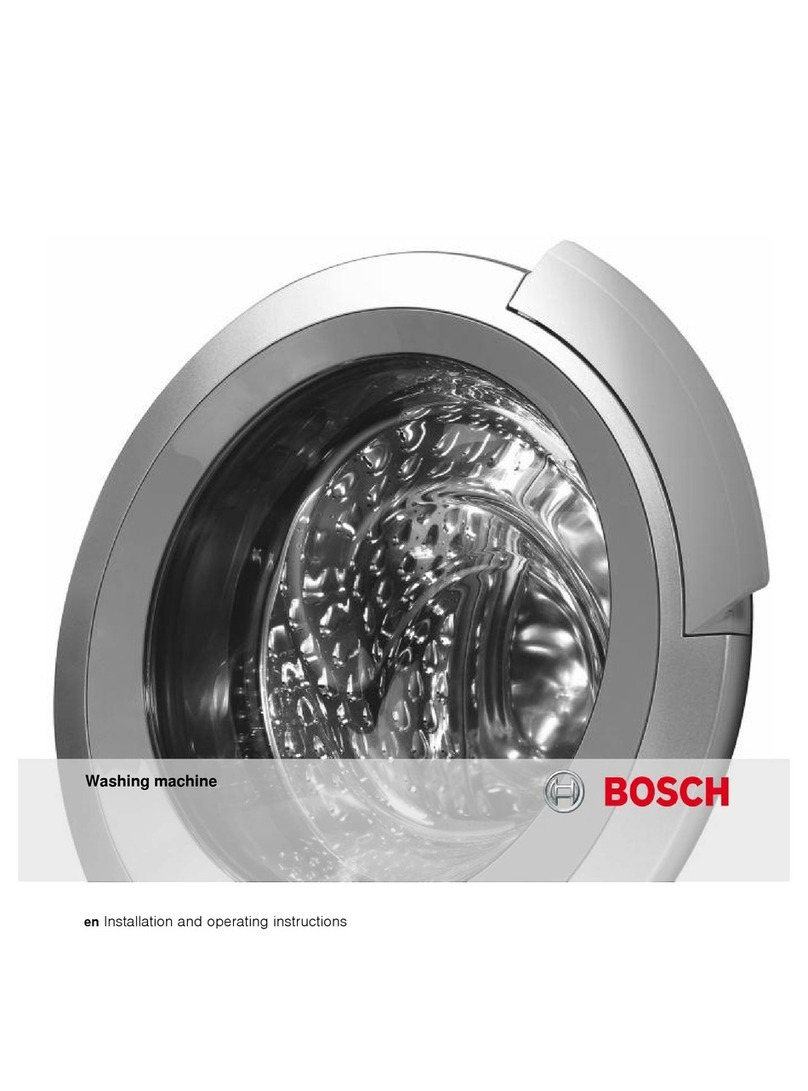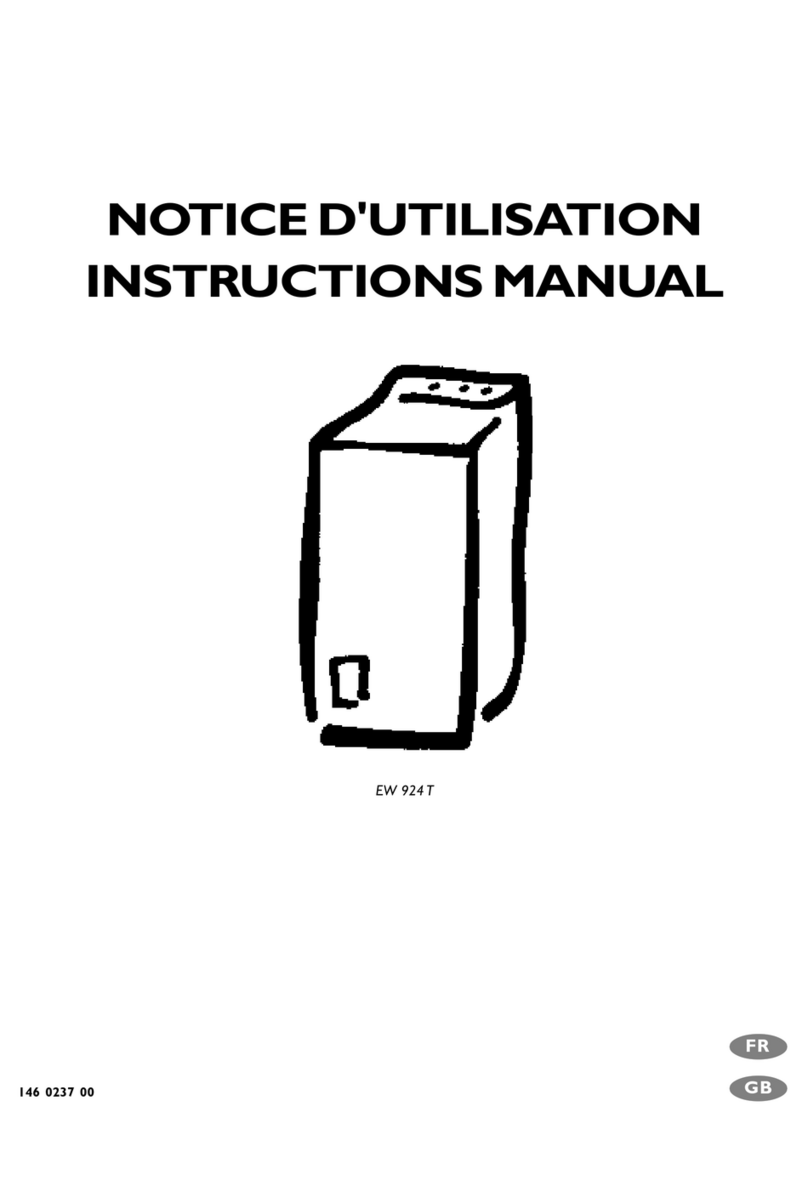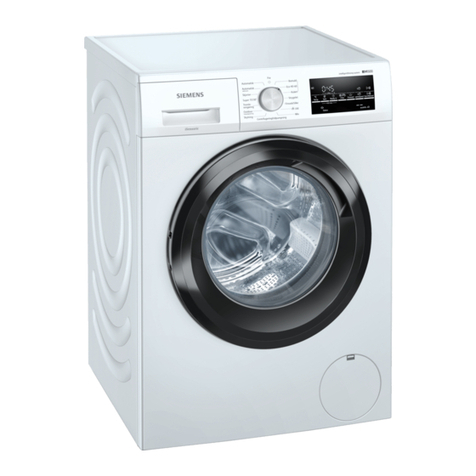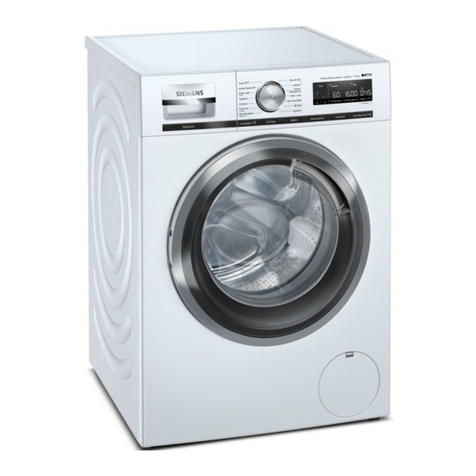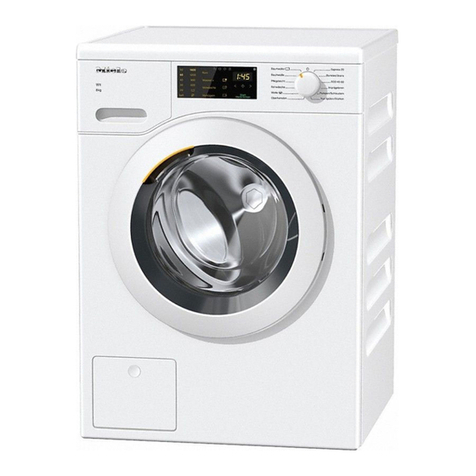B&C Technologies HP series User manual

Washer-Extractor
HP Series Installation and Operation Manual
Revision 2.0
22-Apr-2015
B&C Technologies
Panama City, FL
(850) 249-2222
(850) 249-2226 FAX
www.bandctech.com


Table of Contents Introduction
Customer Service
Replacement Parts
General Specifications
Safety Information
Key Symbols
Safety Checklist
Installation
Theory of Operation
Inspection and Uncrating
HP-65 Technical Specs
HP-125 Technical Specs
Dimensional Clearance
Foundation
Drain Connection
Electrical Installation
Water Connection
Steam Connection
External Chemicals
Function Test
Routine Maintenance
Decomissioning
3
3
4
5
5
6
11
13
14
15
17
18
22
23
24
25
26
29
31
36
B&C Technologies
Panama City, FL
(850) 249-2222
(850) 249-2226 FAX
www.bandctech.com

The B&C HP line is the professional
fixed mount washer-extractor series of
machines from B&C Technologies. It is an
open pocket washer-extractor with a large
door opening for easy and quick loading
and unloading. It has been developed for
the on premise market, and is suitable for
commercial laundries, hotel and other
places where laundry might be processed
The design allows for top
performance at lowest possible operation
cost and investment. The flexible electronic
control center ensures that maximum
productivity is obtained.
The HP series utilizes high quality
material, such as 304 (18/8) stainless steel
in vital parts in contact with the wash
solution. It has a stainless steel cabinet for
long life with easily removable panels.
The key advantages of this series are
the simplicity of the microprocessor and the
electronic AC drive system, which utilizes
only one motor. The system allows for
washing and extraction at any speed and
mechanical action to suit any textile fiber
used today and tomorrow. The high speed
final extraction saves time and energy in the
finishing operation.
A single compartment supply
dispenser for powder and liquid detergents
is standard (five compartment optional) and
the machine is designed to accept the
connection of 8 additional external
chemical lines and pumps. Additional
chemical connections are available as an
option.
The HP series is also prepared to
accept the connection of water reuse
systems. These systems can be installed
separate or on top of the machine. They are
available in either single or dual tanks for
maximum savings of water up to 40%. The
tanks can be equipped with or without
steam or electrical heat depending on
installation and operation. The water reuse
system is programmable by the machines
electronic control center.
Customer Service
For technical assistance, call the following
number:
Phone: (850)-249-2222
FAX: (850) 249-2226
e-mail: ser[email protected]
Web: www.bandctech.com
Replacement Parts
In the event that literature or replacement
parts are required, contact the local
distributor of the equipment, or contact
B&C Technologies at the above phone
numbers/internet addresses.
Introduction
HP Series Washer-Extractors
3

4
Introduction
General Specifications
B
C
A
123
45 6
7 8 9
0
DEL STOP
UNLOCK
DOOR
ADVAN
ENTER
START
B&C
Technologies, Inc.
2000X CONTROL CENTER
MODEL
Metric US
CAPACITY:
kg lbs 29.5 65 56.8 125
A - Width mm in 879 34.6 1295 51.0
B - Depth mm in 1194 47.0 1554 61.2
C - Height mm in 1651 65.0 1669 65.7
Net weight kg lbs 660 1450 1489 3275
Domestic shipping weight kg lbs 720 1584 1505 3310
Diameter mm in 790 31.1 1067 42
Depth mm in 560 22 610 24
Volume liters cu ft 274 9.7 540 19
Wash G rpm 0.8 42 0.8 37
Distribution G rpm 2 67 3 71
Intermediate extract G rpm 150 583 50 290
High extract 1 G rpm 200 673 100 410
High extract 2 G rpm 250 753 150 502
High extract 3 G rpm 300 825 200 579
Diameter mm in 450 17.7 508 20
Height of door bottom above floor mm in 635 25 400 28
Number of motors
Size of motor kW Hp 3.7 5 7.5 10
Hot water size
Cold water size
Additional water inlet
Number of drains
Drain size mm in 76.2 3 76.2 3
Steam inlet size
208-240VAC, 50/60Hz, 1PH Amps Breaker 14 15 n/a n/a
208-240VAC, 50/60Hz, 3PH Amps Breaker 8 15 32 40
380-480VAC, 50/60Hz, 3PH Amps Breaker 4 15 16 20
HP-125
NPT
NPT
NPT
3/4
3/4
3/4
HP-65
Units
DOOR OPENING AND HEIGHT:
Due to our policy of ongoing improvements, all specifications are subject to change without notice.
Number 1
Number 1
1
1
OVERALL DIMENSIONS:
ELECTRICAL SERVICE:
1
1/2
1
STEAM INLET and CONSUMPTION:
WATER INLETS
DRAIN OUTLETS AND CAPACITY:
NPT 1
1
WEIGHT AND SHIPPING INFORMATION:
CYLINDER INFORMATION:
CYLINDER SPEEDS:
DRIVE INFORMATION:

Anyone operating or servicing this machine must follow the safety rules in this manual.
Particular attention must be paid to the DANGER, WARNING, and CAUTION blocks which
appear throughout the manual
The lightening flash
and arrowhead within
the triangle is a
warning sign alerting
you of the presence of
dangerous voltage.
The exclamation point
within the triangle is a
warning sign alerting
you of important
instructions
concerning the machine and possible
dangerous conditions.
This warning symbol
alerts you to the
presence of possible
dangerous drive
mechanisms within
the machine. Guards
should always be in place when the
machine is in operation. Be careful
when servicing any drive mechanism.
This warning symbol
indicates the presence
of possibly dangerous
chemicals. Proper
precautions should be
taken when handling
corrosive or caustic material.
This warning symbol
indicates the presence
of hot surfaces that
could cause serious
burns. Stainless steel
and steam lines can become
extremely hot and should not be
touched.
This warning symbol
indicates the presence
of possible dangerous
pinch-points. Moving
mechanical parts can
crush an/or sever body
parts.
Before servicing any
equipment, make
certain it is
disconnected from the
electrical power
source. Never allow operation of the
machine when any safety device is
malfunctioning. Never bypass safety
devices.
Key Symbols
5

Before Initial start up of a B&C washer
extractor perform the following safety check:
A. Make sure all electrical and plumbing
connections have been made in
accordance with applicable codes and
regulations.
B. Make sure the machine is grounded
electrically.
C. Make sure the machine has flexible
water fill and drain connections of the
correct size, length and type, with no kinks,
and that they are securely attached and/or
clamped.
Before machine is placed in operation, the
door safety interlock must be checked for
proper operation as follows:
A. When the washer is energized
electrically and in operation, the loading
door must be locked in the closed position.
Verify this by attempting to open the
loading door when the machine is
operating. If necessary, check the door
safety interlock and sensors for proper
operation. Consult the service manual, or
call a qualified service technician if
necessary.
B. When the washers loading door is
open, it should not be possible to
start the machine. Verify this by attempting
to start the washer with the door open. Also,
close the door without locking it and verify
that it is not possible to start the machine
with the door not locked. If necessary,
check the door lock sensors for proper
operation,. Consult the service manual, or
Introduction
Safety Checklist
call a qualified service technician. If
additional information is required, contact
your local distributor or call the
manufacturer of the machine.
Before servicing any equipment, make
certain it is disconnected from the electrical
power source. Never allow
operation of the machine
when any safety device is
malfunctioning. Never
bypass safety devices.
6

To provide personal safety and keep the
machine in proper working order, follow all
maintenance and safety procedures
presented in this manual. If questions
regarding safety arise. Contact the factory
immediately.
Use factory authorized spare parts to avoid
safety hazards.
Operator safety
Never insert hands or
objects into basket until it
has completely stopped.
Doing so could result in
serious injury
To ensure the safety of machine operators
the following maintenance checks must be
performed daily.
1. Prior to operating the machine, verify
that all warning signs are present and
legible. Missing or illegible signs must be
replaced immediately. Make certain
that spares are available.
2. Check door interlock before starting
operation of the machine, see safety
check list.
3. Do not attempt to operate the machine if
any of the following conditions are
present:
3.1 The door does not remain securely
locked during the entire cycle.
3.2 Excessively high water level is
evident.
3.3 Machine is not connected to a
properly grounded circuit.
Do not bypass any safety devices in the
machine.
Never operate the
machine with a bypassed
or disconnected out-of-
balance switch. Operating
the machine with severe
out-of-balance loads could
result in personal injury
and serious equipment
damage.
Introduction
Safety Checklist
7

Introduction
Safety Checklist
8
Safe Operation Environment
Safe operation requires an appropriate
operating environment for both the
operator and the machine. If questions
regarding safety arise, contact the factory.
Environmental Conditions
1. Ambient temperature. Water in the
machine will freeze at temperatures of 32F
(0C) or below. Temperatures above 120 F
(50C) will result in more frequent motor
overheating and, in some cases,
malfunction or premature damage to solid
state devices that are used in the machines.
Special cooling devices may be
necessary.
2. Humidity. Relative humidity above 90%
may cause the machine’s electronics or
motors to malfunction or may trip the
ground fault interrupter. Corrosion
problems may occur on some metal
components. If the relative humidity is
below 30% belts and rubber hoses may
eventually develop dry rot. This condition
can result in hose leaks, which may cause
hazards external to the machine in
conjunction with adjacent electrical
equipment.
3. Ventilation. The need for make-up air
openings for such laundry room
accessories as dryers , ironers, water
heaters, etc. must be evaluated
periodically. Louvers, screens, or other
separating devices may reduce the
available air opening significantly..
4. Radio Frequency Emissions. A filter is
available for machines in installations
where floor space is shared with equipment
sensitive to radio frequency emissions. All
machines that are shipped to CE countries
are equipped with this filter and comply
with the EMI regulations.
5. Elevation. If the machine is to be
operated at elevations over 3280 feet
(1000 meter) above sea level, pay special
attention to water levels and electronic
settings ( particularly temperature) or
desired result may not be achieved.
6. Chemicals. Keep stainless steel surfaces
free of chemical residues to avoid corrosion.
7. Water damage. Do not spray the
machine with water. Short circuiting and
serious damage may result. Repair
immediately all seepage due to faulty
gaskets, etc.
Do not place volatile or
flammable fluids in any
machine. Do not clean the
machine with volatile or
flammable fluids such as
acetone, lacquer thinners,
enamel reducers, carbon
tetrachloride, gasoline, benzene, naphtha,
etc. Doing so could result in serious
personal injury and/or damage to the
machine.
Machine Location
1. Foundation. The concrete floor must be
of sufficient strength and thickness to
handle the floor loads generated by the
machine at high extract speeds.

Introduction
Safety Checklist
9
2. Service/ Maintenance Space. Provide
sufficient space to allow comfortable
performance of service procedures and
routine maintenance. This is especially
important in connection with machines
equipped with AC inverter drives. Consult
installation instructions for specific details.
Replace all panels that are removed to
perform service and maintenance
procedures. Do not
operate the machine with
missing guards or with
broken or missing parts.
Do not bypass any safety
devices
Input and output
services
1. Water pressure. Best performance will be
realized if water is provided at a
pressure of 30-85 psi (2.0-5.7 bar).
Although the machine will function properly
at lower pressure, increased fill time will
occur. Water pressure higher than 120
psi (8.0 bar) may result in damage to
machine plumbing. components failure (s)
and personal injuries.
2. Optional Steam heating pressure. Best
performance will be realized if steam
pressure is provided at a pressure of 30-80
psi (2.0-5.4 bar). Steam pressure
higher than 125 psi (8.5 bar) may result in
damage to steam components and
may cause personal injuries. For machines
equipped with optional steam heat,
install piping in accordance with approved
commercial steam practices. Failure to
iinstall the supplied steam filter may void
the warranty.
3. Drainage System. Provide drain lines or
troughs large enough to accommodate
the total quantity of water that could be
dumped if all machines on the site
drained at the same time from the highest
attainable level. If drain troughs are
used, they should be covered to support
light foot traffic
4. Power. For personal safety and for proper
operation, the machine must be
grounded in accordance with state and local
codes. The ground connection must
be to a proven earth ground, not to
conduits or water pipes. An easy-access
disconnect switch should be provided.
Ensure that a ground wire from a proven
earth ground Is connected to the ground lug
in the electrical junction box on this
machine. Without proper grounding
personal injury from electrical shock could
occur and machine malfunctions may be
evident. Computer-controlled machines
must have a proper ground to prevent
computer malfunctions.
Always disconnect power and water
supplies before a service technician
performs any service
procedure. Where
applicable, steam and/or
compressed air supplies
should also be
disconnected before
service is performed

Introduction
Safety Checklist
10
AC Inverter Drive
Machines equipped with AC drives require
special attention with regard to the
operating environment.
1. An especially dusty or linty environment
will require more frequent cleaning of the
AC drive cooling fan filter and of the AC
drive itself.
2. Power line fluctuations from sources such
as an interruptible power supplies (UPS)
can adversely affect machines equipped
with the AC drive. Proper suppression
devices should be utilized on the incoming
power to the machine to avoid problems.
3. A clean power supply free from voltage
spikes and surges is absolutely essential for
machines equipped with the AC drive.
Nonlinear inconsistencies (peaks and
valleys) in the power can cause the AC
drive to generate nuisance errors. If
voltage is above 230V for 200 V
installations or above 440V for 400V
installations, a buck/boost transformer is
recommended. If voltage is above 240V
or 480V, a buck/boost transformer is
required unless the factory advises
differently.
4. Sufficient space to perform service
procedures and routine preventive
maintenance is especially important for
machines equipped with AC drives.
Misuse
Even though this machine is an atmospheric
vessel, never use it for any purpose other
than washing fabrics.
1. Never wash petroleum-soaked rags in the
machine. This could result in an explosion
2. Never wash machine parts or
automotive parts in the machine. This could
result in serious damage to the basket.
3. Never stone wash in the machine. It
could wear the basket and serious damage
might occur to the machine.
4. Never use the machine for dying and
with harsh chemicals that can cause
corrosion and other health hazards.
5. Never allow children to play on or
around this machine. Death or serious
injury can result if children become trapped
in the machine. Do not leave children
unattended while the machine door is open.
these cautions apply to animals as well.

Installation
Theory of Operation
10
The B&C HP models use a single-speed
motor to drive the cylinder via V-belts in all
speeds. The cylinder is supported by two
spherical roller bearings located in a bearing
housing made of cast iron.
The motor is controlled by the computer
control located in the front and the AC
inverter drive located in the rear panel. Any
speed can be programmed for any wash
cycle. Some speed ranges are blocked out
for programming due to safety reasons. This
speed range is not important and normally
speeds for wash or extraction are not
selected within this range. Any wash speed
in the range of 10-50 RPM and extraction
speeds 150-Maximum RPM can be
programmed. Further any reversing action
can be programmed. Normal reversing
action is 18 seconds forward, pause for 3
seconds, and 18 seconds reverse. Any
temperature between 70F to 200F (20-95C)
can be programmed. Any water level in the
range of the machine parameters can be
programmed in centimeters. The computers
will automatically provide safety levels for
steam injections and door operations.
Water entry into the machine is through an
air gap vacuum breaker utilizing electro-
magnetic water valves controlled by the
computer. By utilizing the air gap vacuum
breaker, backflow into the water supply is
impossible. The computer also controls the
drain, supply dispenser, any external liquid
supplies, steam injection and any other vital
functions of the wash program. The
computer can even record cycles and data
of importance that could be used for
maintenance purpose.
The steam, if installed is injected in the
bottom of the shell via a steam injector. The
steam is controlled by a steam valve that is
programmed by the micro computer.
The cylinder is perforated, allowing water to
pass through and drain from within during
drain and extract steps. Lifting ribs inside
the cylinder lift the load from the wash
solution and allow the load to tumble and
falling back into the solution when the load
reaches the approximate 10-11 o’clock or 1-
2 o’clock positions. This mechanical action
removes soil from the fabric. Furthermore,
the lifters are perforated on the top so that
water can cascade over the goods and wet
them quickly. This reduces water
consumption as water is picked up at the
cylinder’s lowest point and lifted and
splashed over the goods at the highest point
as the cylinder rotates.
A stainless steel door is provided for loading
and unloading. A door lock system
prevents operation of the machine when the
door is open. The door is locked during
operation utilizing an air cylinder and a
manual latch for safety reasons. The door
lock is provided with magnetic sensor to
indicate that the machine is locked and
provide for start of the machine when the
door is closed and locked.
The AC drive, contactor, circuit overload
protectors, input power supply connections,
external supply connections, and control
transformer are behind a cover of the rear
of the machine.
The supply dispenser is mounted on the

Installation
Theory of Operation
12
front of the machine and is accessed by
opening the cover door. Supplies, both
liquid and powder; may be added by
pulling the dispenser cups out and placing
the appropriate supply in each. Supplies are
flushed into the machine at the proper time
in the cycle, controlled by the micro
computer.
Holes are provided at the rear of the
machine for connection to an external,
central liquid supply unit. Electrical
connections are provided for the liquid
supply unit on a terminal strip inside the
rear control module. Refer to page for
connection details.

Installation
Inspection and Uncrating
13
Delivery inspection
Upon delivery, visually inspect crate,
protective cover, and unit for any visible
shipping damage. If the crate, protective
cover, or unit are damaged or signs of
possible damage are evident, have the
carrier note the condition on the shipping
document before the shipping receipt is
signed, or advise the carrier of the
conditions as soon as it is discovered.
Remove the crate and protective cover as
soon after delivery as possible. if any
damage is discovered upon removal of the
crate and/or protective cover, advise the
carrier and file a written claim immediately.
Customer Service
If literature or replacement parts are
required contact the source from whom the
machine was purchased or contact :
B&C Technologies
(850) 249-2222
(850) 249-2226 FAX
www.bandctech.com
for the name of the nearest authorized parts
distributor.
A record of each machine is on file with the
manufacturer. The serial number decal is
located at the rear of the machine. Always
provide the machine’s serial number and
model number when ordering parts or
when seeking technical assistance.
NOTE!
Keep the manuals, installation instructions
and the wiring diagrams which accompany
the machine in a safe place for ready
reference. They have been included with
the machine at no charge. Additional copies
are available at a nominal charge.

Installation
HP-65 Technical Specifications
14

Installation
HP-125 Technical Specifications
15

When installing the washer-extractor, it is
important to allow adequate clearance on
all sides of the machine. When multiple
machines are installed, it is important to
allow for the specified minimum clearances
between machines. The following table
shows recommended minimum clearances
for the various freestanding models.
Note
The dimensions are approximate and
subject to normal manufacturing tolerances.
If exact dimensions are required for
construction purposes, request certified
drawings from the factory. We reserve the
right to make changes at any time without
notice.
16
Installation
Dimensional Clearances
A
BC
D
UNITS UNITS
Metric US
(A) Minimum rear clearance mm in 760 30 305 12
(B) Minimum clearance between
machine and wall mm in 455 18 25 1
(C) Minimum clearance between
machines mm in 455 18 25 1
(D) Minimum front clearance mm in 838 33 838 33
HP Series
Recommeded Minnimum

A proper foundation is an absolute
necessity when installing a fixed mount
washer extractor. Do not neglect details
when doing foundation work. These details
will ensure a stable installation, reducing the
possibility of excess vibration at high
speeds.
The machine must be anchored to a smooth
level surface so that the entire base of the
machine is supported and rests on the
mounting surface. Note! Do not support the
machine at only four points.
A concrete base designed to elevate the
washer-extractor to a more comfortable
working height may be used. Use care
when designing a base, as the forces
generated during extract are extreme. The
base must be adequately tied into existing
floor.
Do not attempt to install this machine on
wooden flooring of any kind, above ground
level, or over basements. Installation must
be slab on grade or equal.
Ensure that the machine is installed on a
level floor of sufficient strength and that the
recommended clearances for inspection and
maintenance are
provided. Never allow the
inspection and
maintenance space to be
blocked
17
Installation
Machine Foundation
Floor Load Data
Dynamic
Frequency
lbs kN lbs kN Hz
HP-65 1764 7.85 3906 17.4 13.8
HP-125 3898 17.34 5003 22.3 9.7
Static Load Dynamic Load
Model

Front of Machine
18
Installation
Foundation Bolt Location
Typical Grouting Pattern
5 each side

Select a carbide drill bit
with a diameter equal
to the anchor diameter.
Drill hole to any depth
exceeding the desired
embedment.
Clean hole or continue
drilling to accommo-
date drill fines
(concrete dust).
Please wear eye pro-
tection.
Drive the anchor into
the hole through ma-
terial being fastened
until washer is flush
with material.
Expand bolt by
tightening the anchor
3 to 5 turns, or to the
specified torque re-
quirements.
19
Installation
Mounting Bolt Installation
All B&C washer-extractors must be secured by the use of machinery anchor bolts. High
strength machinery anchors should be embedded in 3500 psi (24000 N/m2) reinforced
concrete. See Figure. For detailed information regarding the machine anchor bolt, see the
instructions included with the anchor bolts themselves. The following information is just an
example.
After the concrete has cured, proceed as follows:
Place the machine adjacent to the foundation. Do not attempt to move it by pushing on the
sides.
1. Remove the wood skid by unscrewing the carriage bolts holding it to the bottom
frame of the machine.
2. Carefully place the machine over the anchor bolts. Raise and level it 1/2 inch
above the floor on four points, using spacers that can be removed.
3. Fill the spaces between the machine base and floor with machinery grout. Grout
completely under the frame members. Remove front panel and rear panel to
gain access to all frame members. Force grout under the machine base until all
voids are filled.
4. Remove the spacers carefully, allowing the machine to settle into the wet grout.
5. Attached the mounting bolt washers and lock nuts to the anchor bolts after the
grout has hardened. Tighten the lock nuts by even increments-one after the
other-until all are tightened evenly and the machine is fastened securely to the
floor. The nuts should be tightened in a diagonal fashion, which will help ensure
equal tension at all anchor points.
Other manuals for HP series
1
Table of contents
Other B&C Technologies Washer manuals
